The London, Midland and Scottish Railway (LMS) inherited several styles of coaching stock from its constituents. Stock built by the LMS itself can be categorised into three separate periods, numbered I to III.

A Driving Brake Standard Open (DBSO) is a type of railway carriage, converted to operate as a control car. Fourteen such vehicles, numbered 9701 to 9714, were converted from Mark 2F Brake Standard Open carriages. Modifications included adding a driving cab and TDM equipment to allow a locomotive to be driven remotely. Using a system known as push–pull, the driver in the DBSO can drive the locomotive, even though it is at the rear of the train.
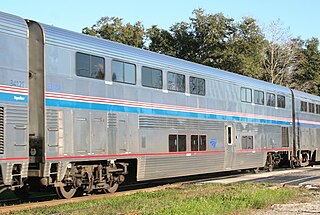
A passenger railroad car or passenger car, also called a passenger carriage, passenger coach, or passenger bogie (India) is a railroad car that is designed to carry passengers. The term passenger car can also be associated with a sleeping car, a baggage car, a dining car, railway post office and prisoner transport cars.
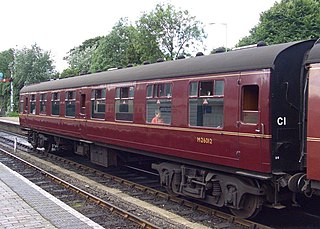
The Second Corridor type of railway carriage was one of the standard mid-20th century designs, and was coded SK by the LNER and BR, and CF by the LMS. The layout of the coach was a number of compartments, all of which were second class, linked by a side corridor.

The Mark 2 family of railway carriages are British Rail's second design of carriages. They were built by British Rail workshops between 1964 and 1975. They were of steel construction.

The British Rail Mark 3 is a type of passenger carriage developed in response to growing competition from airlines and the car in the 1970s. A variant of the Mark 3 became the rolling stock for the High Speed Train (HST).

The Corridor First type of railway coach was one of the standard mid-20th century designs; coded 'FK' by the LNER and BR, and 'CL' by the LMS. The layout of the coach was a number of compartments, all of which were first class, linked by a side corridor. The British Railways produced versions were numbered in the 13xxx series. The prototype Mark 2 carriage, number 13252, was of FK design. It is now preserved at the Mid-Norfolk Railway, having been preserved by the National Collection.
A wide variety of hauled coaches have been used on the railways of Ireland. This page lists all those since 1945.
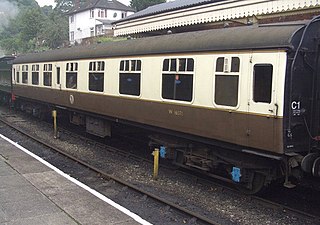
The Composite Corridor is a railway coach with a number of compartments, some of which are standard class and some first class, linked by a side corridor.

British Rail Class 416 (2-EPB) was a class of third-rail electric multiple units in service between 1953 and 1995. They were intended for inner suburban passenger services on London's Southern Electric network. There were two subclasses of Class 416: Class 416/1 to an SR design on salvaged 2-NOL underframes, built between 1953 and 1956, and Class 416/2 based on a British Railways Mark 1 coach design.
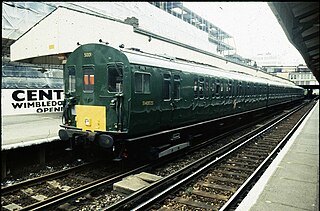
British Rail Class 415 was a suburban 750 V DC third rail electric multiple unit commissioned by the Southern Region of British Railways. Built between 1951 and 1957, it became the most numerous class on the region after the withdrawal of the 4SUBs. The final trains were withdrawn in the 1990s, replaced by Class 455, 456, 465 and 466.

A Brake Standard Open (Micro-Buffet), often abbreviated to BSOT or BSO(T), is a type of railway carriage used by British Rail.
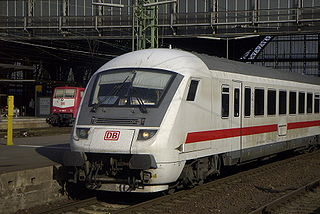
A control car, cab car, control trailer, or driving trailer is a generic term for a non-powered railroad (US) or railway (UIC) vehicle that can control operation of a train at the end, opposite to the position of the locomotive. They can be used with diesel or electric motive power, allowing push-pull operation without the use of an additional locomotive. They can also be used with a power car or a railcar. In a few cases control cars were used with steam locomotives, especially in Germany and France.

The Brake Gangwayed or BG coach is a type of British Railways Mark 1 passenger brake van. It has a guard's compartment in the centre and two large areas either side for storing luggage. They were a very versatile type of coach and could be found all over the British Railways network and some are still in use today - although not in conventional use. The British Railways Mark 1 BG was shorter than most other types of Mark 1 coach – the BGs being 57 feet (17.37 m) whereas most other designs were 63 feet (19.20 m). This was so the BG could go everywhere unlike their other Mark 1 counterparts which were banned from some station platforms because of their length.
The rolling stock used on the Isle of Man Railway today is entirely original but the serviceable passenger coaches number 14, out of an original total of 75 carriages. The 3 ft gauge railway was provided with a variety of stock from different manufacturers over its time, and types of coach were categorised according to a lettering system, with the original four-wheeled coaches being of A, B, C and D types, and so on. The F prefix encompassed all bogie vehicles including conversions from the A-D series. Letters G-M denoted goods stock. N referred to ex-Manx Northern Railway 6 wheel carriages. The types of stock can be summarised as follows:-

A First Open or FO, is a type of railway carriage used by British Rail and subsequent operators since privatisation. They were first produced as British Railways Mark 1, and subsequently Mark 2, Mark 3, and Mark 4 variants were produced. This type of carriage is an "open coach" because of the arrangement of the seats inside – other types of carriage may be corridor based variants (FK) or have a brake compartment.

The S type carriages are a corridor-type passenger carriage used on the railways of Victoria, Australia. The first carriages were constructed by the Victorian Railways in 1937 for use on the Spirit of Progress, with additional carriages built for other trains until the mid-1950s.

A compartment coach is a railway passenger coach divided into separate areas or compartments, with no means of moving between compartments.

The London Underground opened in 1863 with gas-lit wooden carriages hauled by steam locomotives. The Metropolitan and District railways both used carriages exclusively until they electrified in the early 20th century. The District railway replaced all its carriages for electric multiple units, whereas the Metropolitan still used carriages on the outer suburban routes where an electric locomotive at the Baker Street end was exchanged for a steam locomotive en route.

The Southern Railway Maunsell carriage was the first design family of railway carriages built by Southern Railway (SR) in the United Kingdom. Following grouping in 1923, SR had continued to build carriages to the designs of the previous three main companies, and the Maunsell carriage was intended to be the standard carriage design for use across the Southern Railway lines, incorporating the best features of each of the former companies' designs.

















